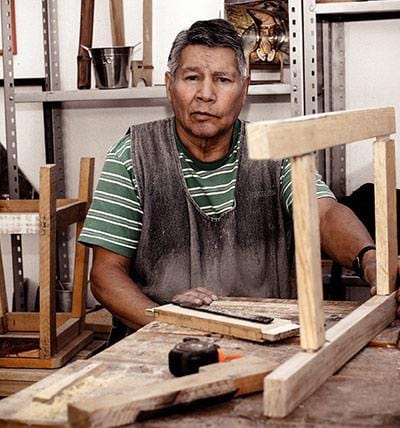Ask someone to cite an example of a power saw, and it’s most likely that the first thing that would come to their mind will be a chainsaw.
There can be many reasons for this; maybe they watch too many thriller movies or have one in the garage. Regardless, chainsaws remain a popular and well-known tool for woodworking.
When delving into the beginner's guide to chainsaws, it's crucial to keep safety a top priority, and you can rely on the expertise of professionals like Tree Wisemen of Omaha to provide valuable advice and assistance.
However, dealing with chainsaws is no easy task. It requires skills and intense training so you can use it without causing harm to other people, to yourself, or any nearby property.
A single mistake may result in severe physical damage or the loss of one life. That said, it’s in your best interest to wear protective gear, such as chainsaw chaps, to prevent such consequences.
In addition, although chainsaws are infamous for being destructive, no one can deny their versatility and capabilities that go far beyond slicing a tree in half. Therefore, since they’re often an essential item for a homeowner or a contractor, it’d be a good idea to learn everything about them, including their uses and the safe way to use them.
If you want to learn more about chainsaws, read this article until the end.

What is a Chainsaw?
On the surface, a chainsaw is simply a saw with a blade and a chain that keeps it running in a continuous motion. Things may get a little more complex than that—but it’s nothing that you can’t comprehend.
By true definition, a chainsaw is a portable metal saw with a sharp saw blade connected to a chain across the guide bar. This equipment produces a continuous motion, resulting in a versatile and multi-sided cutting edge.
Compared to other power saws, the cutting action of a chainsaw is significantly different—except for a bandsaw, which also runs in a continuous motion.
Aside from that, chainsaws and bandsaws couldn’t be the same any longer. Ideally, one shouldn’t use chainsaws in basic woodworking tasks, such as cutting a plank of wood or slicing a wooden board into many pieces. It is because of the thick teeth of the saw blade that may not cut wood as precisely as needed. Instead, they’re best used in cutting trees. After this you can use wood pieces to create anything from furniture to the wooden boxes. And when performing such tasks, wearing appropriate tree climbing gear to prevent damage and injury (more about this later) is necessary.
What are the Uses of Chainsaws?
You can use chainsaws in several ways, such as felling or limbing a tree. Here are some of the ways you might want to know:
Tree felling
Tree felling is one of the earliest uses of chainsaws. It’s the process of removing a tree from the ground by cutting around the base of the trunk and letting it fall on its own. Although the goal of tree felling is relatively simple, it requires tons of planning and professional skills. Without these two, you might be putting your life at risk.
Back in the days when chainsaws didn’t exist, lumberjacks used two-person handsaws manually operated by pulling back and forth. Aside from that, they also use axes for chopping down smaller trees. That said, the development of chainsaws made the process of removing trees more effortless.
Tree limbing
As its name implies, tree limbing is the process of removing limbs or branches from the main trunk of a tree. This process is a critical part of timbering, where a tree is prepared before dividing into pieces and selling as lumber in the market.
Decades ago, tree limbing could only be executed with a handsaw, which made the process extremely dangerous and time-consuming. People back then risked themselves getting injured by falling tree branches. Now, thanks to chainsaws, you don’t have to worry about such risks.
However, keep in mind the risks of using chainsaws. Ensure you know how to operate it properly and wear appropriate protective gear, such as trousers and other tear-resistant equipment. These will keep you safe from the razor-sharp blades of a running chainsaw.
Tree bucking
Tree bucking is the process of cutting down a felled or a limbed tree into pieces of logs. Also, it’s usually considered the most critical step of the timbering process. Although it sounds plain and simple, the process actually takes many things into consideration. These include:
- The length of the lumber
- The thickness of the lumber
- The defects lumber may have contained
By considering these points, the lumber you produce can have a higher market value and better quality for woodworking. Also, you’ll be able to compete with other renowned businesses in the lumber industry.
Tree pruning
Tree pruning is the process of removing unnecessary parts of the tree. Unlike others mentioned above, the primary purpose of this process is to keep the tree in good condition rather than being removed completely. There are many reasons for tree pruning, such as:
- Eliminating diseased branches to prevent the disease from spreading across the entire tree
- Getting rid of unsightly branches to improve the aesthetic appeal of the tree
- Removing dead tree branches to make the tree look healthier and prevent them from falling unexpectedly, which may cause serious physical injuries
- Eliminating some branches to allow new ones to grow beautifully and healthily
- Getting rid of branches that fail to grow decently to achieve the desired appearance of the tree
- Furthermore, tree pruning is vital for the growth and development of the tree. It should be done regularly to ensure that the tree will grow healthily and nicely.

Creating firebreaks
Creating firebreaks—gaps between trees and other vegetation—is one of the firefighting techniques that’s often executed to prevent or halt the spreading of wildfires. This process allows firefighters to control wildfires threatening nearby villages and cities as much as possible. However, creating firebreaks is no simple task. Timing is very critical in the process. Firefighters should be able to slice down a grove of trees as quickly as possible to ensure that the fire will die out eventually once it reaches the firebreak point.
Creating firewood
Creating firewood is one of the most common uses of a chainsaw. Whether the wood is from another area or from the tree you’ve sliced down, using a chainsaw is the fastest way to cut the wood into pieces appropriate for a campfire or a fireplace. It makes the process of producing firewood a lot easier compared to using axes and handsaws.
How to Ensure Safety When Using a Chainsaw?
As mentioned earlier, chainsaws are destructive and should only be used with caution and proper training. Even a simple mistake may cause serious injuries, damage your property, and claim your life. It is why learning how to use a chainsaw properly is critical. That said, here are the things you might want to consider when using a chainsaw:
Know your limits
First and foremost, stop using a chainsaw if you’re not confident enough to handle it. If you think using one is too much for you, don’t hesitate to call an expert to help you out. This way, you’ll be able to prevent unfortunate circumstances due to a lack of experience, knowledge, and confidence.
Choose the right chainsaw
As a beginner, it’s in your best interest to use lighter chainsaws that would help you perform minor cutting tasks around the garden. On the other hand, it’d be best to let the major tasks, such as tree felling, be handled by professionals. While they’re onto it, watch and learn how they do it. Then, try to do it yourself next time but with proper guidance for safety purposes.
Check your chainsaw before getting started
Before you start the engine, you want to ensure that the machine is in ideal condition. That said, here’s a checklist of the things you need to evaluate before turning the machine on:

- Check if its parts are well-lubricated
- Check if its chain has proper tension
- Check if its teeth are razor-sharp
- Check if there are loose parts
- Check if all safety tools and devices are in place
- Ensure that all of these are addressed before you begin—not even a single point should be left out. Otherwise, you might increase the risk of getting injuries and causing damage.
- Use Protective Equipment
Keep this on top of your mind: accidents may occur no matter how careful you are. It is why wearing protective gear is crucial when using a chainsaw. So, when cutting any object with this machine, you want to make sure that you’re wearing:
- Hearing protection to keep your ears safe from the sound of the equipment.
- Use prescription safety glasses to keep your eyes safe from flying wood splinters and sawdust.
- Protective boots with metal toecap to protect your feet should you drop your chainsaw.
- Protective clothing to avoid getting wounded by the chainsaw.
- An arborist-specific helmet to protect your head from falling tree branches.
Don’t use a chainsaw without the following personal protective equipment mentioned above—even if you’re someone who has more than ten years of experience using chainsaws.
Final Words
Chainsaws are one of the power tools often used in a wide range of applications. These include felling, limbing, pruning, bucking a tree, and creating firewood and firebreaks. Remember to handle chainsaws with extreme caution to avoid unfortunate circumstances. To ensure safety while using a chainsaw, wear appropriate gear, know your limits, choose the right one, and check it before using it.
ABOUT THE AUTHOR
Fred Felton
Content Creator / Editor
Fred Felton is a copywriter, editor and social media specialist based in Durban, South Africa. He has over 20 years of experience in creating high end content. He has worked with some of the biggest brands in the world. Currently Fred specialises in the wooden arts and crafts space, focussing on innovative wooden product design. He is also a keynote speaker and has presented talks and workshops in South Africa.






